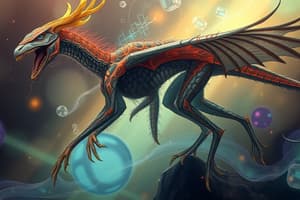Podcast
Questions and Answers
Which of the following characteristics is used to differentiate between Eubacteria and Archaebacteria?
Which of the following characteristics is used to differentiate between Eubacteria and Archaebacteria?
- Mode of reproduction
- Habitat
- Cell wall composition (correct)
- Presence of a nucleus
In binomial nomenclature, the genus name is written in lowercase, and the species name begins with a capital letter.
In binomial nomenclature, the genus name is written in lowercase, and the species name begins with a capital letter.
False (B)
List the levels of classification in order from broadest to most specific.
List the levels of classification in order from broadest to most specific.
Kingdom, Phylum, Class, Order, Family, Genus, Species
The close association between two different species where both organisms benefit is known as ______.
The close association between two different species where both organisms benefit is known as ______.
Which of the following is NOT a characteristic of plants in the Kingdom Plantae?
Which of the following is NOT a characteristic of plants in the Kingdom Plantae?
Match the following plant types with their primary function:
Match the following plant types with their primary function:
Vascular plants lack specialized tissues for transporting water and nutrients.
Vascular plants lack specialized tissues for transporting water and nutrients.
Using a dichotomous key, if the first question is 'Does the organism have a backbone? Yes -> go to 2; No -> go to 5,' what is the next logical step when identifying an earthworm?
Using a dichotomous key, if the first question is 'Does the organism have a backbone? Yes -> go to 2; No -> go to 5,' what is the next logical step when identifying an earthworm?
What is the role of stomata in plant adaptation to terrestrial environments?
What is the role of stomata in plant adaptation to terrestrial environments?
A non-native species that enters a new ecosystem and causes harm is best described as an ______ species.
A non-native species that enters a new ecosystem and causes harm is best described as an ______ species.
Which symbiotic relationship is exemplified by a tapeworm living in a human's intestine?
Which symbiotic relationship is exemplified by a tapeworm living in a human's intestine?
Exotic species always cause harm to their new ecosystems.
Exotic species always cause harm to their new ecosystems.
Which of the following adaptations would you expect to find in a plant living in a cold environment?
Which of the following adaptations would you expect to find in a plant living in a cold environment?
What are the primary functions of roots in plants?
What are the primary functions of roots in plants?
The kingdom that consists of eukaryotic heterotrophs with cell walls made of chitin is ______.
The kingdom that consists of eukaryotic heterotrophs with cell walls made of chitin is ______.
Flashcards
Taxonomy
Taxonomy
The science of naming and categorizing living things.
Binomial Nomenclature
Binomial Nomenclature
A system using two names (genus and species) to identify organisms.
Levels of Classification
Levels of Classification
Domain, Kingdom, Phylum, Class, Order, Family, Genus, Species
Eubacteria
Eubacteria
Signup and view all the flashcards
Archaebacteria
Archaebacteria
Signup and view all the flashcards
Protista
Protista
Signup and view all the flashcards
Fungi
Fungi
Signup and view all the flashcards
Plantae
Plantae
Signup and view all the flashcards
Animalia
Animalia
Signup and view all the flashcards
Dichotomous Key
Dichotomous Key
Signup and view all the flashcards
Symbiosis
Symbiosis
Signup and view all the flashcards
Mutualism
Mutualism
Signup and view all the flashcards
Commensalism
Commensalism
Signup and view all the flashcards
Parasitism
Parasitism
Signup and view all the flashcards
Invasive Species
Invasive Species
Signup and view all the flashcards
Study Notes
Taxonomy and Classification
- Taxonomy involves naming and categorizing living organisms.
- Carl Linnaeus created the classification system over 250 years prior.
- The classification system is based on shared physical and structural features.
- Binomial Nomenclature identifies organisms using a two-part name.
- The two parts are the genus and the species.
- Acer rubrum (Red Maple) exemplifies Binomial Nomenclature.
- The genus is Acer (maple trees).
- The species is rubrum (a specific type of maple).
- Binomial names are italicized, with the genus underlined if handwritten.
- The seven levels of classification include Kingdom, Phylum, Class, Order, Family, Genus, and Species.
Kingdoms of Life
- Eubacteria are unicellular, prokaryotic, and microscopic.
- Some Eubacteria have Flagella are whiplike structures that enable some unicellular organisms, particularly Eubacteria, to move in their environment..
- Their cell walls are composed of peptidoglycan.
- Examples include Escherichia coli, Cyanobacteria, Borrelia burgdorferi, and Staphylococcus aureus.
- Eubacteria are gram-positive or gram-negative.
- Archaebacteria are unicellular, prokaryotic, and reproduce asexually, and some produce methane
- They inhabit extreme environments like hot springs, salty lakes, and deep-sea vents.
- Examples include Euryarchaeota, Bathyarchaeota, and Lokiarchaeota.
- Protista are plant-like, animal-like, or fungi-like, mostly aquatic, and contain membrane-bound organelles
- They can be autotrophic or heterotrophic.
- Examples include red algae, Amoeba, Euglena, and Plasmodium.
- Fungi are eukaryotic heterotrophs with cell walls and act as decomposers.
- They are filamentous, composed of hyphae, reproduce sexually or asexually.
- Examples include pennybun, wood ear, corn smut, and liberty cap.
- Plantae are multicellular, non-motile, and photosynthetic, and contain photosynthetic pigments
- They reproduce sexually and asexually.
- Examples include cacti, roses, tomatoes, peace lilies, and orchids.
- Animalia are multicellular, heterotrophic, and motile (can move).
- They lack cell walls, possess sensory and excretory organs, and reproduce sexually.
- Examples include dogs, cats, horses, lions, and tigers.
Classification Keys
- Dichotomous Keys identify organisms using a series of choices.
- An example of a dichotomous key:
- Does the specimen come from a maple tree?
- Yes → proceed to the next question.
- No → it is not a maple leaf.
- Do the lobes form a V or U shape?
- V → it is a silver maple leaf.
- U → it is a sugar maple leaf.
- Does the specimen come from a maple tree?
Symbiotic Relationships
- Symbiosis encompasses close associations between two species.
- Mutualism benefits both organisms. An example is lichens and algae.
- Commensalism benefits one organism, with no effect on the other. An example is clownfish and sea anemones.
- Parasitism benefits one organism while harming the other. An example is tapeworms and humans.
Plant Biology
- Plants consist of two main types: vascular and non-vascular.
- Non-vascular plants lack vascular tissue (e.g., mosses, liverworts).
- Vascular plants possess specialized tissues for transport (e.g., ferns, trees, flowers).
- Plant parts include roots, stems, leaves, and flowers.
- Roots absorb water and nutrients.
- Stems support the plant and transport substances.
- Leaves conduct photosynthesis.
- Flowers facilitate reproduction.
- Transport occurs via xylem and phloem.
- Xylem transports water and minerals from roots to leaves.
- Phloem transports sugars and nutrients from leaves to the rest of the plant.
- Stomata are tiny openings on leaves.
- Stomata control gas exchange and water loss.
- Adaptation refers to traits that aid survival in an environment.
- Desert plants possess thick stems for water storage and reduced leaves to minimize water loss.
- Aquatic plants have large air spaces for flotation and stems that are flexible.
- Cold environment plants have needle-like leaves to minimize water loss.
- Invasive species are non-native organisms thriving and harming ecosystems.
- Examples include zebra mussels and purple loosestrife.
- Exotic species are non-native species introduced to a new area, and may compete with native species for resources.
- Plant biodiversity is important.
- It provides oxygen, food, medicine, and habitat.
- It maintains ecosystem stability and resilience.
- It protects against climate change and habitat destruction.
Studying That Suits You
Use AI to generate personalized quizzes and flashcards to suit your learning preferences.




